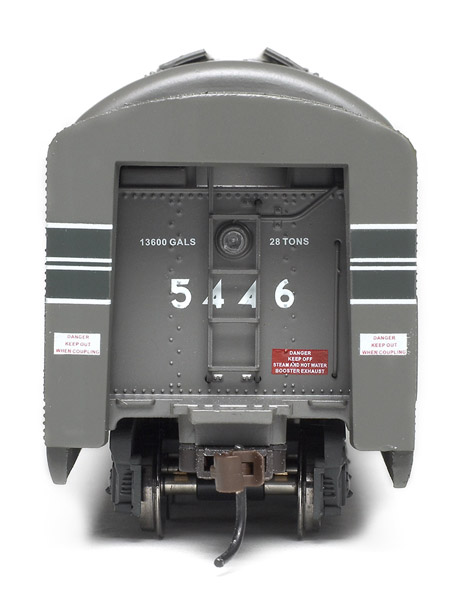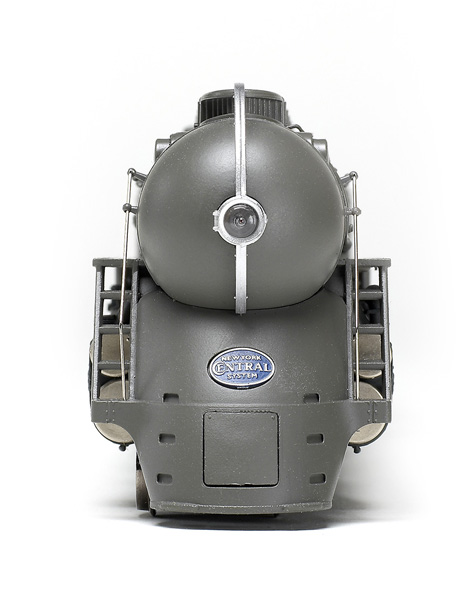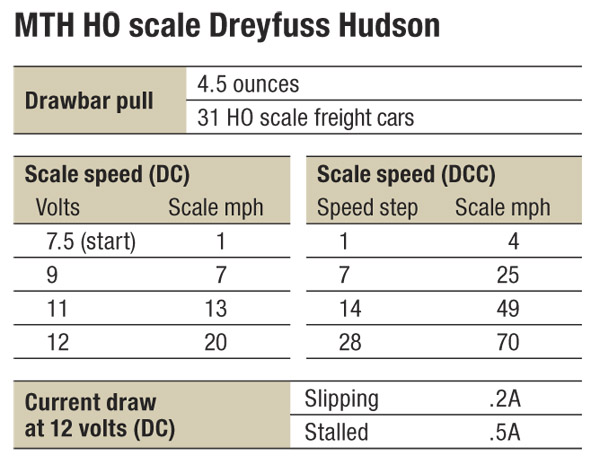Prototype. In 1938 the New York Central RR re-equipped its New York-to-Chicago name train, the 20th Century Limited, with streamlined lightweight passenger cars. The railroad hired famed industrial designer Henry Dreyfuss to develop a streamlined version of a class J3a 4-6-4 Hudson steam locomotive. Dreyfuss also designed the train’s paint scheme and the cars’ interiors. The resulting design became an American icon and was soon featured in posters for the 1939 New York World’s Fair.
The last ten J3a Hudsons built, nos. 5445 to 5454, were streamlined in 1938. Five of the locomotives had Box-Pok drivers (like the model shown here), and five had Scullin disk drivers. The locomotives produced 3,880 drawbar hp at 65 mph, but their service on the Century was short-lived. General Motors Electro-Motive Division E7 diesels took over the job of hauling the Century in March 1945, and by 1947 all the Dreyfuss Hudsons had their streamlining removed.
All the dimensions of the MTH model match prototype drawings in the April 1988 Model Railroader.
Separately applied details include metal handrails and piping. The safety valves and whistle are correctly positioned in recesses in the boiler’s skyline casing.
It would have been helpful if the tender coupler had been factory installed. When I installed the coupler, I found that filing the front lip off the coupler lid box allowed the coupler to swing and center more reliably.
Our sample came decorated in the 1940 paint scheme. Placement of the lettering and striping matches prototype photos. All the colors look correct when compared to color photos from the 1940s.
The cab interior is also well done, with painted valve handles and gauges. Painted engineer and fireman figures are included.
Drivetrain. The can motor and flywheel are housed inside the loco-motive boiler and transfer power through a driveshaft to a gearbox on the second driver axle. Both main drivers have traction tires. The siderods transfer power to the other drivers. This drivetrain and the model’s hefty die-cast metal construction give the MTH Dreyfuss Hudson more than enough power to pull a full 16-car Century.
Additional electronics, including a speaker, are in the tender. A pin on the tender connects to the locomotive drawbar. Contacts inside the drawbar and pin eliminate the need for a wiring harness.
There are two holes in the drawbar. Placing the pin in the hole at the end of the drawbar allows the engine to negotiate a minimum radius of 18″. For a closer, more prototypical spacing between the locomotive and tender, you can use the hole farther inboard and the user-installed shorter cab apron that’s included. This close spacing requires a 44″ minimum radius.
In DC, lights and sound came on at 6.5 volts and the model started moving at 7.5 volts. Although our standard speed test for DC goes up to 12 volts, the model reached a 50 scale mph top speed at 14.8 volts, which is the maximum voltage of our Model Rectifier Corp. Tech 4 power pack. The instruction manual states that the engine will reach a prototypical top speed at about 16 volts, and that the model can handle a maximum of 24 volts.
The smoke unit worked well in all three modes, producing heavy puffs of smoke synchronized to the correct four chuffs per driver revolution. The smoke on/off switch and a master volume knob are under the tender water hatch. The amount of smoke can also be adjusted with a DCS system or with functions 8 and 18 in DCC.
I accessed all 29 of the model’s user-controlled functions in DCC and DCS modes. Some interesting features include function 4, which toggles through a four-part Chicago station arrival and departure sequence. Functions 22 to 24 activate different crew dialogue sequences. I appreciated that I could shut off the automatic crew dialogue with function 27.
Ten of the model’s configuration variables are programmable in DCC. These CVs mainly allow the modeler to change the short and long addresses and adjust the acceleration and deceleration rates. The model must be programmed on the main.
Although its DCC programming options are limited, the MTH Dreyfuss Hudson is fun to operate. The locomotive looked great puffing smoke while hauling HO models of NYC’s “Great Steel Fleet” around our club layout.
Price: $449.95
Manufacturer
MTH Electric Trains
7020 Columbia Gateway Dr.
Columbia, MD 21046-1532
www.mthhotrains.com
Road numbers (all New York Central): 5446, 5445 (1940 livery), 5453 (1940 livery with Scullin disk drivers), 5448, 5449 (1938 livery)
Era: 1938 to 1947
Features
Automatically switches between DC, Digital Command Control, and MTH Digital Command System modes
Electrical pickup on four drivers and all tender wheels
Engine and tender weight:
2 pounds 21/2 ounces (Engine alone: 1 pound 31/2 ounces)
Fan-driven smoke unit
Five-pole skew-wound motor with brass flywheel
Metal RP-25 contour wheels in gauge
Minimum radius: 18″
Optional drivers without traction tires
Proto-Sound 3.0 system operates on DC, DCC, and DCS
Sprung drivers
User-installed magnetic knuckle couplers at correct height

















